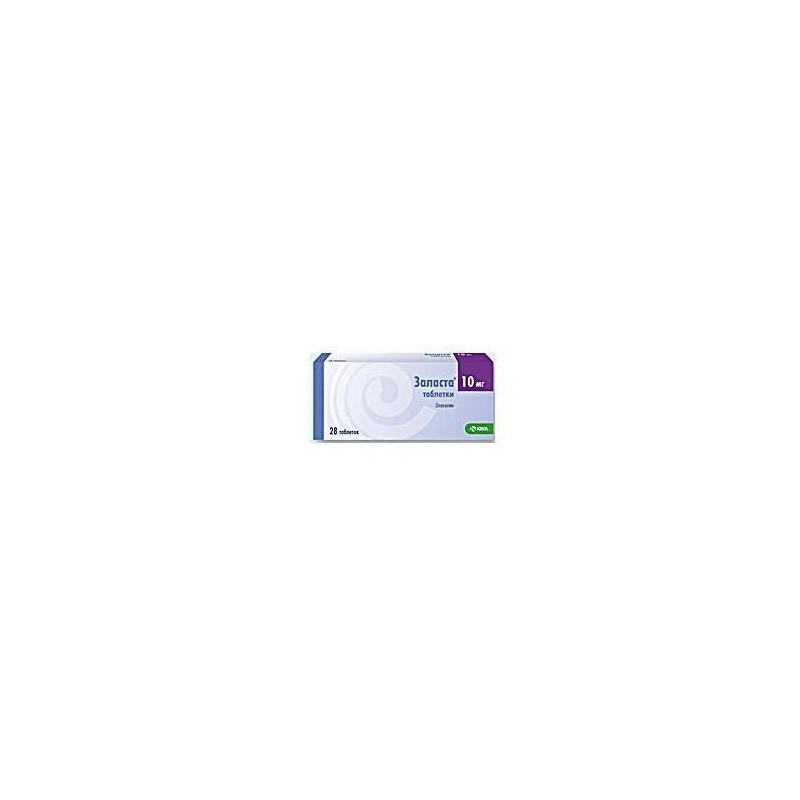



 All payments are encrypted via SSL
All payments are encrypted via SSL
 Full Refund if you haven't received your order
Full Refund if you haven't received your order
28 pcs.
Zalasta has an antipsychotic, neuroleptic effect.
Due to the limited experience of using the drug in pregnant women, olanzapine should be used only if the expected benefit to the mother justifies the potential risk to the fetus. Women should be informed about the need to inform the doctor about the occurrence or planned pregnancy during olanzapine therapy. There are isolated reports of tremor, arterial hypertension, lethargy and drowsiness in children born to mothers who took olanzapine in the third trimester of pregnancy. The study found that olanzapine is secreted in breast milk.The average dosage (mg / kg) received by the child upon reaching the equilibrium concentration in the mother was 1.8% of the dose of mother olanzapine (mg / kg). Breast-feeding during olanzapine therapy is not recommended.
The drug should be taken orally, regardless of the meal - 5-20 mg / day. For schizophrenia in adults, the recommended starting dose is 10 mg / day. In acute mania associated with bipolar disorders in adults, 15 mg / day (1 time) as monotherapy or 10 mg / day (1 time) in combination with Li + or valproic acid (maintenance therapy at the same dose). With depression associated with bipolar disorders in adults - 5 mg / day (1 time) in combination with 20 mg of Fluoxetine (if necessary, changes in doses of drugs are allowed). Elderly patients, patients with risk factors (including severe chronic renal failure or moderately severe liver failure), with a combination of risk factors (female, old age, non-smokers) that can slow down the metabolism of olanzapine, reduce the initial dose to 5 mg / days
When treating with neuroleptics (including olanzapine), neuroleptic malignant syndrome (hyperthermia, muscle rigidity, change in mental status, autonomic disorders, including unstable pulse or blood pressure, tachycardia, cardiac arrhythmias, increased sweating, increased CK) may develop., myoglobinuria as a result of rhabdomyolysis, acute renal failure). In identifying the clinical manifestations of neuroleptic malignant syndrome (including hyperthermia without others.symptoms) requires the elimination of olanzapine. If signs of tardive dyskinesia develop, a dose reduction or elimination of olanzapine is recommended. Symptoms of tardive dyskinesia may increase or manifest after discontinuation of the drug. When taking olanzapine (in studies), cerebrovascular disorders (stroke, transient ischemic attack), including deaths, were observed in elderly patients with psychosis on the background of dementia. These patients had previous risk factors (cerebrovascular disorders (in history), transient ischemic attack, arterial hypertension, smoking), as well as concomitant diseases and / or drug intake associated with cerebrovascular disorders. Olanzapine is not recommended for the treatment of patients with psychosis on the background of dementia. Special precaution is needed when increasing the activity of ALT and / or AST in patients with hepatic insufficiency or receiving treatment with potentially hepatotoxic drugs. Patient monitoring and dose reduction are required. There is a higher prevalence of diabetes in patients with schizophrenia. Cases of hyperglycemia, development of diabetes mellitus or exacerbation of pre-existing diabetes mellitus, ketoacidosis and diabetic coma have been very rarely observed. The causal relationship between antipsychotic drugs and these conditions has not been established. Clinical monitoring of patients with diabetes mellitus or with risk factors for its development is recommended.Olanzapine should be used with caution in patients with a history of epileptic seizures or in the presence of factors that reduce the threshold of convulsive readiness. Olanzapine should be used with caution in patients with a decrease in the number of leukocytes and / or neutrophils, with signs of inhibition or toxic impairment of bone marrow function under the influence of drugs (in history), with inhibition of bone marrow function due to concomitant disease, radio or Chemotherapy (in history ); with hypereosinophilia or myeloproliferative disease. The use of olanzapine in patients with clozapine-dependent neutropenia or agranulocytosis (in history) was not accompanied by a recurrence of these disorders. It is recommended to exercise caution when prescribing olanzapine in patients with prostatic hypertrophy with clinical manifestations, paralytic ileus, angle-closure glaucoma. Olanzapine antagonizes dopamine and, in theory, can suppress the effects of levodopa and dopamine agonists. Caution must be exercised when using olanzapine in combination with other drugs of central action and ethanol. During the period of treatment, care must be taken when driving and engaging in potentially hazardous activities that require increased concentration and psychomotor speed.
Symptoms: very often (> 10%) - tachycardia, agitation / aggression, dysarthria, various extrapyramidal symptoms, decreased consciousness from lethargy to coma; in less than 2% of cases, delirium, convulsions, coma, neuroleptic malignant syndrome (MNS), respiratory depression, aspiration, increased or decreased blood pressure, cardiac arrhythmia; in very rare cases, cardiopulmonary failure.The minimum dose of olanzapine in acute overdose with a fatal outcome is 450 mg, the maximum dose in case of overdose with a favorable outcome (survival) is 1500 mg.
Treatment: gastric lavage, taking Activated carbon (reduces the bioavailability of olanzapine by 60%), symptomatic treatment under the control of vital functions, including the treatment of arterial hapotension and vascular collapse, maintaining respiratory function. There is no specific antidote. It is not recommended to induce vomiting, use epinephrine, dopamine or other sympathomimetics with beta-adreno-mimetic activity, since the latter may aggravate hypotension. To identify possible arrhythmias, monitoring of cardiovascular activity is necessary. The patient must be under continuous medical supervision until full recovery.
At temperatures not above 25 ° C.
5 years.
